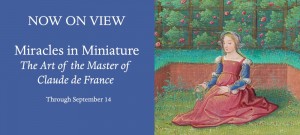 Anecdotally, we think we know that interest in “older art” is waning, and a smaller pool of those anecdotes suggest that it’s partly because of their subject matter. In this increasingly secular age, religious subjects — and some historical subjects — seem to be of less interest to some art-lovers and collectors. When a story or a symbol is involved — even as simple as a lily, representing purity, or a fish, for Christ — people miss the significance. In 2009, The Art Newspaper wrote about this problem, and how the Victoria and Albert Museum dealt with it when reopening its revamped Medieval and Renaissance Galleries.Â
Anecdotally, we think we know that interest in “older art” is waning, and a smaller pool of those anecdotes suggest that it’s partly because of their subject matter. In this increasingly secular age, religious subjects — and some historical subjects — seem to be of less interest to some art-lovers and collectors. When a story or a symbol is involved — even as simple as a lily, representing purity, or a fish, for Christ — people miss the significance. In 2009, The Art Newspaper wrote about this problem, and how the Victoria and Albert Museum dealt with it when reopening its revamped Medieval and Renaissance Galleries.Â
The subject has been on my mind since then.
Earlier this year, when I reported on the sale of the Rothschild prayer book, it was striking that a masterpiece that was fought over by five bidders in 1999, when it sold for $13.379 million, had only one bidder in January. It sold for $13.605 million. While some of the difference in interest has to do with the big-time money flowing increasingly into contemporary art; some — sources told me — probably had to do with the religious nature of a prayer book.
One expert I spoke with for that story was Roger S. Wieck (at left), curator of Medieval and Renaissance Manuscripts at the Morgan Library & Museum* — who is so steeped, so knowledgeable, about illuminated manuscripts, which are mostly devotional, and about the liturgy and about Biblical stories, that I was surprised when he told me he was a non-believer.
So I decided to use Wieck as a hook to talk about interest in religious art now, at least on a mini-scale. The result is half-profile, half-exposition of his exhibit now on view at the Morgan: Miracles in Miniature: The Art of the Master of Claude de France.
Published today by Al Jazeera America, the piece explains why Wieck grew interested in illuminated manuscripts as he was studying art history. And he also explains a couple of the attractions held by Medieval and Renaissance art, which is mostly religious in nature, that other categories don’t have:
“It’s the variations on a theme that’s so appealing,†he says, naming one: “It’s so interesting to see how many variations there are on the Annunciation. Is there a lily? Where does the artist put the lily? How is the Holy Spirit shown: a dove, a stream of light?â€Â
I’d never thought about that before, but he is absolutely correct. Then, later in the article:
…Wieck also notes that in an era when art appreciation frequently involves seeking out works by well-known artists, “One of the attractions of medieval art is that it’s not signed and is insecurely attributed, so it’s not about names. We don’t know who the Master of Claude de France is. We know by the eye that something is by him. That aspect I find challenging and very rewarding because all the judgments are about what you see.â€
You can see a digital facsimile of the Prayer Book of the Master of Claude de France, btw — right here. But I hope after reading my article, you’ll also want to go see the exhibit.
Photo credits: Courtesy of the Morgan Library and Museum
*I consult to a foundation that supports the Morgan.

